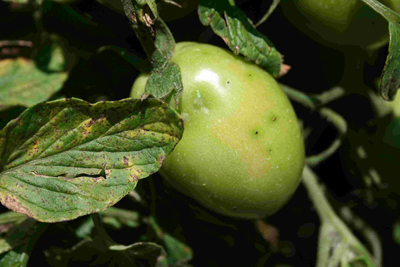$4M grant to explore plant-pathogen 'cat and mouse' games
By Krishna Ramanujan

The arms race between plants and pathogens prompts both to evolve: Pathogens continually find new strategies to infect plants, and plants counter by foiling those strategies.
Now, Cornell and Boyce Thompson Institute (BTI) researchers have received a $4 million National Science Foundation Plant Genome Research Program grant to explore plant-pathogen interactions in order to create more resistant crops.
The researchers, headed by Alan Collmer, professor of plant pathology and plant-microbe biology; Gregory Martin, a BTI scientist; and Dilip Panthee, a tomato breeder at North Carolina State University, are specifically studying the relationship between tomato and the model pathogen Pseudomonas syringae pv. tomato, which causes bacterial speck disease in tomatoes. The research will provide a methodology that may be applied to many other plant-pathogen systems.
The grant is the third in a series of NSF grants to the Cornell-BTI group to study Pseudomonas-tomato interactions, dating back to 2000.
In the plant-pathogen interaction, the plants' innate immune system uses proteins called kinases to sense the presence of potential pathogens and send signals to the inside of the cell so it can respond appropriately.
"This signal transduction system tells the plant if it's worth mounting an expensive defense," said Collmer.
At the same time, the pathogens inject effector proteins into the plant's cells, which sabotage the plant's surveillance system. Collmer and colleagues have now identified 28 such effector proteins for P. syringae tomato.
"You cannot defeat the plant's surveillance with just one, two or three effector proteins," he said; instead it takes the right combination of a minimal set of eight or more such proteins.
"Up until now we have identified all of the saboteurs for this one pathogen, knocked them all out and used a novel DNA shuffling system to figure out what the minimal set of effector proteins might be to defeat the plant's surveillance system," Collmer said.
The DNA shuffling system allows the researchers to take a large set of effector proteins produced by a pathogen and test the effectiveness of all possible combinations of any five or so proteins in sabotaging the plant's detection systems.
By understanding how the effectors work, both individually and in concert with other proteins, to break down the plant's surveillance, the researchers gain an understanding of the "architecture of the signaling network in the plant's immune system," Collmer said.
With this new grant, Martin and colleagues Sorina Popescu and Zhangjun Fei at BTI plan to explore natural variation in the kinase surveillance system of wild tomato species. Different wild tomatoes have different plant defense strengths, so the team will try to understand those strengths and then combine them in a cultivated tomato to produce a crop that cannot be defeated by pathogen effectors and is durably resistant.
An outreach component of the grant includes functional genomic Web resources, developed by Magdalen Lindeberg, a Cornell senior research associate in plant pathology and plant-microbe biology, for the worldwide research community that is using P. syringae as a model pathogen, and a computer game being developed by Wells College computer scientist Bryant Adams that is based on molecular plant-microbe interactions but uses a "spy vs. spy" theme, complete with decoys and double agents.
Media Contact
Get Cornell news delivered right to your inbox.
Subscribe